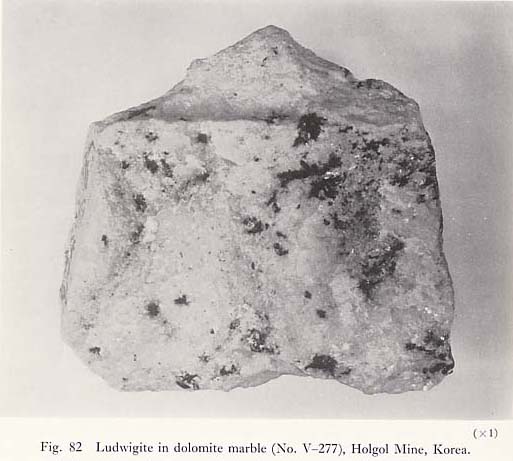Magnesite, MgCO3, Trigonal R![]() c
c
< Specimen No. V-1 >
Specimen No. V-1, from Majeon-ri, Korea, occurs as gangue mineral in a lead zinc deposit, and forms a black to dark grey massive aggregate.
Smithsonite, ZnCO3, Trigonal, R![]() c
c
< Specimen No. V-2 >
Specimen No. V-2, from the Hosokura Mine, Miyagi Pref., occurs in fractures and cavities of a sphalerite-bearing quartz vein, and forms spherical aggregates of fine acicular crystals yellowish brown in colour.
Siderite, FeCO3, Trigonal, R![]() c
c
< Specimens No. V-3—No. V-10 >
Specimens Nos. V-3 & V-4, from the Ashio Mine, Tochigi Pref, occur on crystalline quartz in drusy cavities in a sphalerite-pyrite-quartz vein, and form botryoidal aggregates of brown minute crystals with curved faces.
Specimen No. V-5, from the Ikuno Mine, Hyogo Pref., occurs on crystalline
quartz in drusy cavities of a quartz vein, and forms flat pale brown botryoidal
aggregates of rhombohedral crystals with r(10![]() 1).
1).
Specimens No. V-6—No. V-9, from the Akenobe Mine, Hyogo Pref., occur in drusy cavities of a quartz vein, and form aggregates of flat rhombohedra grown with parallel main axes as in specimens Nos. V-6 & V-7. Specimen No. V-9 forms stalactitic needle-shaped aggregates. They are pale brown to brown in colour.
Specimen No. V-10, the Omori Mine, Shimane Pref., occurs as gangue mineral in an epithermal gold-silver-quartz vein, and forms a yellowish brown aggregate of rhombohedra showing a rosette-like form.
Rhodochrosite, MnCO3, Trigonal, R![]() c
c
< Specimens No. V-11—No. V-20 >
Specimens No. V-l 1—No. V-14, from the Oye Mine, Hokkaido, occur as gangue mineral in a sphalerite-chalcopyrite-pyrite ore. The crystals are found in drusy cavities, and form pink rhombohedra up to 1 cm in diameter.
Specimens No. V-15—No. V-l7, from the Taisei (Oishi) Mine, Akita Pref., occur in an epithermal rhodochrosite-quartz vein, are associated with alabandite and calcite, form massive aggregates of small rhombohedral crystals in druses, and show a bright rosy colour.
Specimen No. V-18, from the Rendaiji Mine, Shizuoka Pref., occurs in drusy cavities of a quartz vein from an epithermal copper-gold-silver deposit, and forms pink botryoidal aggregates.
Specimens Nos. V-19 & V-20, from the Kuradani Mine, Ishikawa Pref, occur in drusy cavities of a quartz vein in association with galena, chalcopyrite, pyrite and jamesonite, and form rosettle-like aggregates of flat rhombohedra.
Calcite, CaCO3, Trigonal R![]() c
c
< Specimens No. V-21—No. V-154 > (Figs. 70-72)
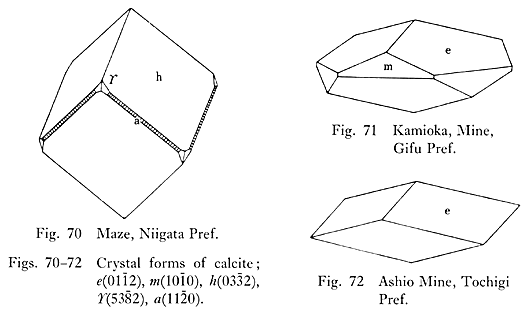
Specimens No. V-21—No. V-39, from the Furokura Mine, Akita Pref,
occur in drusy cavities of quartz veins, are associated with chalcopyrite
and pyrite in an epithermal copper deposit, and form scalenohedral crystals
with v(21![]() 1) (specimens Nos. V-22
& V-23), and twins of the scalenohedral crystals on (0001) or (02
1) (specimens Nos. V-22
& V-23), and twins of the scalenohedral crystals on (0001) or (02![]() 1)
(specimens No. V-27, No. V-28 and No. V-30). The crystals are white to yellowish
white in colour and transparent to semi-transparent. The largest crystal is
8 cm in length. Specimens Nos. V-25 & V-39 are pale pink and transparent crystals
with well-developed w(31
1)
(specimens No. V-27, No. V-28 and No. V-30). The crystals are white to yellowish
white in colour and transparent to semi-transparent. The largest crystal is
8 cm in length. Specimens Nos. V-25 & V-39 are pale pink and transparent crystals
with well-developed w(31![]() 5) and
n(41
5) and
n(41![]() 3). Sometimes twins as in
specimen No. V-39 are intimately associated with scalenohedral single crystals
(Fig. 73).
3). Sometimes twins as in
specimen No. V-39 are intimately associated with scalenohedral single crystals
(Fig. 73).
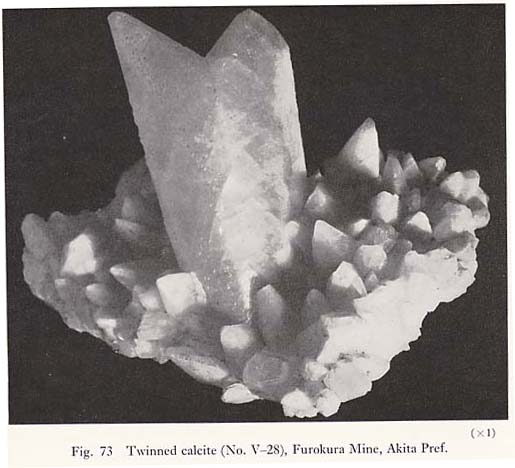
Specimens No. V-40—No.V-45, from the Ani Mine, Akita Pref., occur
as white and transparent crystals grown on chalcopyrite and galena crystals
in drusy cavities in an epithermal chalcopyrite-galena-quartz vein. The crystals
form rhombohedra with f(02![]() 1)
or e (01
1)
or e (01![]() 2) as in specimens Nos.
V-40 & V-44, and scalenohedra with v(21
2) as in specimens Nos.
V-40 & V-44, and scalenohedra with v(21![]() 1)
and r(10
1)
and r(10![]() 1) and reaching 1 cm
in length as in specimens Nos. V-42 & V-43.
1) and reaching 1 cm
in length as in specimens Nos. V-42 & V-43.
Specimens No. V-46—No. V-66, from the Arakawa Mine, Akita Pref.,
occur on crystalline quartz in druses of an epithermal chalcopyrite-pyrite-quartz
vein, and form groups of single and twinned crystals. The former are scalenohedral
with v(21![]() 1), and the latter twinned
on e(01
1), and the latter twinned
on e(01![]() 2) are platy and parallel
to a pair of Ω(6.5.
2) are platy and parallel
to a pair of Ω(6.5.![]()
![]() .1),
showing a butterfly-like appearance as in specimens Nos. V-53 & V-54. They
are colourless to pale pink and transparent (Figs. 74 & 75).
.1),
showing a butterfly-like appearance as in specimens Nos. V-53 & V-54. They
are colourless to pale pink and transparent (Figs. 74 & 75).


Specimen No. V-67, from the Hisaichi Mine, Akita Pref, occurs on crystalline
quartz in drusy cavities of a chalcopyrite-pyrite-chlorite-quartz vein, and
forms a group of scalenohedral crystals with v(21![]() 1).
They are up to 1 cm in length.
1).
They are up to 1 cm in length.
Specimens No. V-68—No. V-75, from the Mizusawa Mine, Iwate Pref, occur in druses in a quartz vein and are associated with chalcopyrite and pyrite. The crystals form rhombohedra or hexagonal prisms and are yellow to white in colour and transparent.
Specimen No. V-76, from the Karatoya Mine, Yamagata Pref, occurs in
drusy cavities in a quartz vein of an epithermal copper deposit, and forms
dark brown hexagonal tabular crystals, up to 1 cm in size. Faces observed
are c(0001) and m(10![]() 0).
0).
Specimens No. V-77—No. V-92, from the Ashio Mine, Tochigi Pref,
occur in drusy cavities in a chalcopyrite-galena-sphalerite ore bearing quartz
and small crystals of arsenopyrite and pyrrhotite. They form groups of hexagonal
prismatic crystals as in specimens No. V-77, No. V-78 and No. V-79, tabular
crystals as in specimen No. V-80, and scalenohedral crystals as in specimens
Nos. V-81 & V-82. The faces well developed are c(0001), e(01![]() 2),
y(32
2),
y(32![]() 1) and m(10
1) and m(10![]() 0)
in the hexagonal crystals and G(52
0)
in the hexagonal crystals and G(52![]() 9),
v(21
9),
v(21![]() 1) and Ω1(6.5.
1) and Ω1(6.5.![]()
![]() .1)
in the scalenohedral crystals. Sometimes flat rhombohedral crystals form rosette
aggregates and are in parallel growth as in specimen No. V-92.
.1)
in the scalenohedral crystals. Sometimes flat rhombohedral crystals form rosette
aggregates and are in parallel growth as in specimen No. V-92.
Specimens No. V-93—No. V-95, from the Chichibu Mine, Saitama
Pref., occur in cavities in a massive magnetite ore from a contact iron deposit,
and form short prismatic small crystals with e(01![]() 2)
and ρ(16.0.
2)
and ρ(16.0.![]()
![]() .1).
Associated minerals are crys- talline quartz and spherical aggregates of siderite.
.1).
Associated minerals are crys- talline quartz and spherical aggregates of siderite.
Specimens Nos. V-96 & V-97, from Wanabasawa of the Chichibu Mine,
Saitama Pref, occur in a contact metamorphosed saccharoidal limestone, and
form rhombohedral crystals, up to 2 cm in diameter, with a combination of
c(0001), r(10![]() 1) and f(02
1) and f(02![]() 1),
white in colour and transparent.
1),
white in colour and transparent.
Specimen No. V-98, from Kunugidaira, Saitama Pref., occurs in drusy
cavities in a calcite vein cutting through limestone, and forms transparent
rhombohedral or scalenohedral crystals up to a few centimeters in diameter.
In the scalenohedra, r(10![]() 1) develops
into a large face (Fig. 76).
1) develops
into a large face (Fig. 76).

Specimens No. V-99—No. V-104, from Futagoyama, Saitama Pref., occur in druses in a calcite vein in limestone, and form transparent crystals yellowish grey to white. Rhombohedral faces develop.
Specimen No. V-105, from Miyanohama, Chichijima Isl., Tokyo, occurs in drusy cavities in andesite, is associated with heulandite crystals, and forms transparent scalenohedra measuring 1 cm in diameter.
Specimens No. V-106—No. V-108, from the Amagi Mine, Shizuoka Pref, occur in druses in quartz from an epithermal gold-silver deposit. The crystals are transparent scalenohedra and rhombohedra with rough and dull faces. The largest crystal measures 2 cm in diameter.
Specimens Nos. V-109 & V-110, from the Senami Hot Spring, Niigata
Pref., occur as precipitation product from the hot spring, and form incrustations
and massive aggregates. On the surface of the incrustation, rhombohedral crystals
grow with r(10![]() 1) and up to 5
mm in diameter.
1) and up to 5
mm in diameter.
Specimens No. V-111—No. V-114, from the Sado Mine, Niigata Pref,
occur in druses in a quartz vein of an epithermal gold-silver deposit, and
form scalenohedra with v(21![]() 1)
and the combinations of e(01
1)
and the combinations of e(01![]() 2)
and m(10
2)
and m(10![]() 0), though these faces
are often dull. They are about 5 mm in size, and white in colour. Tabular
crystals of barite is associated.
0), though these faces
are often dull. They are about 5 mm in size, and white in colour. Tabular
crystals of barite is associated.
Specimens No. V-115—No. V-122, from the Takachi Mine, Niigata Pref., occur on crystalline quartz in a gold-silver-quartz vein, are associated with chalcopyrite and galena, and form rhombohedra and tabular aggregates of scalenohedra in parallel growth as in specimens Nos. V-117 & V-120. The aggregates measure 8 cm in diameter and 1 cm in thickness on an average, and are pale pink in colour due to a small amount of manganese.
Specimens Nos. V-123 & V-124, from the Omodani Mine, Fukui Pref.,
occur on crystalline quartz in drusy cavities in a chalcopyrite-pyrite-quartz
vein, and form rhombohedral crystals with e(01![]() 2),
attaining 1 cm in diameter.
2),
attaining 1 cm in diameter.
Specimens No. V-125—No. V-129, from the Kamioka Mine, Gifu Pref.,
occur in druses in a massive calcite from a contact lead-zinc deposit in association
with sphalerite and galena, and form short prismatic or flat crystals with
e(01![]() 2) and m(10
2) and m(10![]() 0)
as in specimens Nos. V-125 & V-126, and scalenohedra as in specimen No. V-127.
They are white to light yellow and transparent.
0)
as in specimens Nos. V-125 & V-126, and scalenohedra as in specimen No. V-127.
They are white to light yellow and transparent.
Specimen No. V-130, from Akasakamachi, Gifu Pref., occurs as a stalactite
in a limestone-cave. The crystal face at the apex of the stalactite is e(01![]() 2).
It is 5 cm long, white and translucent.
2).
It is 5 cm long, white and translucent.
Specimens No. V-131—No. V-139, from the Kanagase Deposit of the Ikuno
Mine, Hyogo Pref., occur on crystalline quartz in drusy cavities in a
chalcopyrite-sphalerite-quartz vein, and form hexagonal flat or short prismatic
crystals with e(01![]() 2) and m(10
2) and m(10![]() 0),
measuring 2 to 6 cm in diameter. Specimen No. V-139 is scalenohedra with v(
21
0),
measuring 2 to 6 cm in diameter. Specimen No. V-139 is scalenohedra with v(
21![]() 1) and γ(53
1) and γ(53![]() 2).
2).
Specimens Nos. V-140 & V-141, from the Akenobe Mine, Hyogo Pref.,
occur in drusy cavities in a quartz vein, are associated with fluorite, and
form flat crystals with e(01![]() 2),
somehow looking like a lens. The largest crystal is 5 cm in diameter.
2),
somehow looking like a lens. The largest crystal is 5 cm in diameter.
Specimen No. V-142, from the Takeno Mine, Hyogo Pref., occurs on crystalline quartz in a drusy cavity of a gold-silver-quartz vein. Calcite is in rosette aggregates of tabular crystals, white with pinkish tint and translucent.
Specimen No. V-143, from Saigomachi, Oki Isl., Shimane Pref., occurs
as a calcite vein filling a fracture in shale. In druses of the vein, yellow
and transparent flat crystals with e(01![]() 2)
grow.
2)
grow.
Specimen No. V-144, from the Obie Mine, Okayama Pref., occurs as vein mineral in a chalcopyrite-quartz vein. In its druses, yellow and transparent hexagonal tabular crystals up to 1 cm in diameter grow.
Specimens No. V-145—No. V-147, from the Yoshioka Mine, Okayama
Pref., occur in drusy cavities in a calcite vein of a contact copper deposit,
and form short prismatic crystals with the dominant faces of c(0001) and m(10![]() 0),
and sometimes associated with acicular scalenohedra. They are colourless and
transparent, and measure 1 cm in average diameter (Fig. 77).
0),
and sometimes associated with acicular scalenohedra. They are colourless and
transparent, and measure 1 cm in average diameter (Fig. 77).
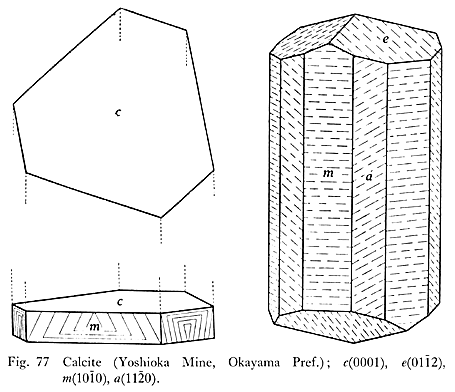
Specimen No. V-148, from the Yamato (Ofuku) Mine, Yamaguchi Pref., occurs in fractures of an oxidized zone in a contact metasomatosed copper deposit, and forms groups or aggregates of transparent scalenohedral crystals measuring 1 cm in diameter.
Specimen No. V-149, from the Yamagano Mine, Kagoshima Pref., occurs
as a dark grey coloured massive aggregate in an epithermal gold-silver-quartz
vein. In its drusy parts, platy crystals with e(01![]() 2)
are found in association with fine crystalline quartz.
2)
are found in association with fine crystalline quartz.
Specimen No. V-150, from the Cheongam Mine, Korea, occurs on crystalline
quartz in a quartz vein. The crystals are flat rhombohedra with e(01![]() 2),
white and translucent.
2),
white and translucent.
Specimen No. V-151, from the Yulpo Mine, Korea, forms hexagonal prismatic crystals attaining 3 cm long, and shows pale yellow colour.
Specimens Nos. V-152 & V-153, from the Tempozan Mine, China, form transparent rhombohedral crystals, occurring in drusy parts in massive calcite from a contact deposit.
Specimen No. V-154, from Cumberland, England, forms a transparent
prismatic crystal with m(10![]() 0)
and y(32
0)
and y(32![]() 1) well-developed.
1) well-developed.
Calcareous oolite
< Specimens No. V-155—No. V-157 >
Specimens No. V-155—No. V-157, from Takasegawa, Nagano Pref., occur as precipitation product in a hot spring, and form rounded or irregular-shaped globules with a concentric texture and white in colour. Sometimes, globules assume a curious dodecahedral form whose edges are rounded and whose pentagonal faces are slightly depressed at the centre. These globules reach 1 cm in diameter.
Dolomite, CaMg(CO3)2, Trigonal, R![]()
< Specimens Nos. V-158 & V-159 >
Specimens Nos. V-158 & V-159, from Gue, Ishikawa Pref., occurs as massive aggregates of white coloured granular crystals in a recrystallized limestone including small flaky graphite.
Ankerite, Ca(Fe, Mg, Mn) (CO3)2, Trigonal R![]()
< Specimens No. V-160—No. V-162 >
Specimen No. V-160, from the Taisei Mine, Akita Pref, occurs in drusy cavities in a chalcopyrite-quartz vein as an aggregate of pale yellowish rhombohedral crystals.
Specimens Nos. V-161 & V-162, from Wulcheon-ri, Korea, occur in a quartz vein and are associated with calcite and quartz.
Aragonite, CaCO3, Rhombic, Pmcm
< Specimens No. V-163—No. V-180 >
Specimens Nos. V-163 & V-164, from the Arakawa Mine, Akita Pref, occur in fractures of a chalcopyrite-quartz vein as secondary mineral in an oxidized ore, and form groups of transparent prismatic crystals with m(110), b(010), k(011) and p(111).
Specimen No. V-165, from the Shiozawa Mine, Ibaraki Pref, occurs on
the wall of an abandoned adit of the coal mine, and forms white stalactitic
aggregates of fine acicular crystals radially arranged. This form of aragonite
is called " mountain coral " because of its close resemblance to coral (Fig.
78).
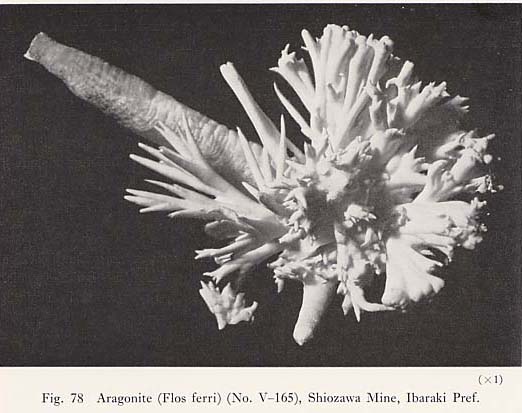
Specimen No. V-166, from Katsuyama, Chiba Pref., occurs in a fracture in serpentinite as aggregates of transparent needle-like crystals up to 1 cm in length.
Specimens Nos. V-167 & V-168, from Kashio, Nagano Pref., occur in fractures in serpentinite as mammillary incrustations with banded texture of layers, one being light brown and the other dark brown.
Specimen No. V-169, from the Otakigawa, Nagano Pref., occurs in serpentinite as vein mineral. In its drusy part, the crystals grow in a prismatic form with m(110), b(010) and p(111). They are white and transparent.
Specimens Nos. V-170 & V-171, from the Mozumi Deposit of the Kamioka Mine, Gifu Pref., occur as secondary mineral in fractures of a contact metasomatosed lead-zinc deposit, and form aggregates, either in botryoidal incrustations or in stalactitic masses, of acicular crystals. They are white, slightly bluish, and transparent.
Specimen No. V-172, from the Matsushiro Mine, Shimane Pref, is spherical
aggregates reaching 25 cm in diameter and with radial texture of short prismatic
aragonite crystals, and occurs in a decomposed clay derived from tuff associated
with a gypsum deposit. The aggregates are composed mostly of trillings of
short prismatic crystals pale purple or grey and transparent (Plate 10).

ARAGONITE (No. V-172) Matsushiro Mine, Shimane Pref.
Specimens No. V-173—No. V-179, from Bokoto Isl., Formosa, occur in cavities in basalt as mammilary incrustations with banded and concentric texture. Their colour varies from yellowish brown to deep brown.
Specimen No. V-180, from France, occurs in a reddish clay-bed as a pseudohexagonal short prismatic trilling of crystals (three intergrown individuals) up to 3 cm in length. It is reddish brown in colour due to clay inclusions.
Witherite, BaCO3, Rhombic, Pmcn
< Specimen No. V-181 >
Specimen No. V-181, from the Hassei (Tsubaki) Mine, Akita Pref.,
occurs in drusy cavities in a Kuroko deposit and is crystallized in hexagonal
prisms, each of which is a penetration trilling of individuals in a rhombic
prism and reaching 1 cm in length. It is white in colour and transparent to
translucent (Fig. 79).
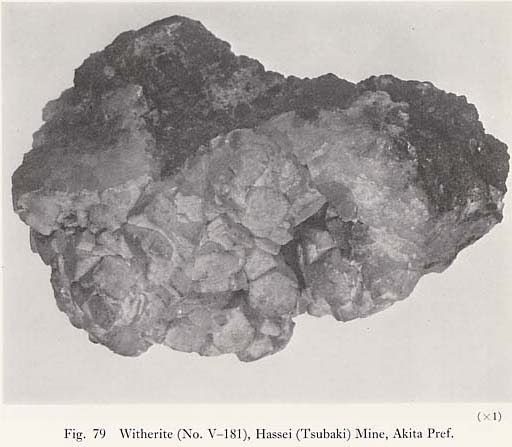
Cerussite, PbCO3, Rhombic, Pmcn
< Specimens No. V-182—V-239 >
Specimens No. V-182—No. V-234, from the Kisamori Mine, Akita
Pref., occur in fractures or cavities in an oxidized ore from a chalcopyrite-pyrite-galena-sphalerite-quartz
vein. The single crystals are short prismatic or tabular with a(100), m(110),
b(010), p(111), i(021) and c(001), and up to 5 cm in length as in specimens
Nos. V-182, V-183 and V-207. Cerussite also occurs in a fibrous form with
high silky lustre as in specimens Nos. V-207 & V-208. The crystals show two
modes of habit when twinned: one is a hexagonal pyramid, due to trilling on
p(111) as in specimens Nos. V-186 & V-189, and the other a six-rayed stellate
trilling with re-entrant angles as in specimens No. V-191, No. V-196 and V-209.
The commonest faces are m(110), p(111), a(100) and b(010). Associated minerals
are malachite, linarite and amorphous iron oxide (Plate 10 & Fig. 80).
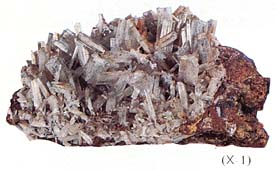
CERUSS1TE (No. V-202) Kisamori Mine, Akita Pref.

Specimens No. V-235—No. V-237, from the Yamato (Ofuku) Mine, Yamaguchi Pref., occur in fractures in an oxidized ore from a contact metasomatosed copper deposit, and form aggregates of fibrous crystals yellowish white in colour with silky lustre. The surface of the aggregate is stalactitic.
Specimens Nos. V-238 & V-239, from the Ongiin Mine, Korea, occur in fractures of an oxidized galena-sphalerite-chalcopyrite ore, and form yellowish and transparent tabular or prismatic crystals, often in trillings. They are 10 mm long on an average.
Azurite, Cu3 [OH|CO3]2, Monoclinic, P21/c
< Specimens No. V-240—No. V-249 >
Specimen No. V-240, from the Kisamori Mine, Akita Pref., occurs as small tabular crystals in cavities in an oxidized copper ore and is associated with fibrous aggregates of cerussite and botryoidal incrustations of malachite.
Specimen No. V-241, from the Hisaichi Mine, Akita Pref., occurs in fractures of an oxidized copper ore as secondary mineral and forms crystals tabular on c(001).
Specimen No. V-242, from the Otani Mine, Niigata Pref., occurs in
drusy cavities in a quartz vein, is associated with malachite, and forms radial
aggregates of small prismatic crystals with m(110), a(100), c(001), v(10![]() )
and θ(
)
and θ(![]() 01).
01).
Specimens No. V-243—No. V-247, from the Rendaiji Mine, Shizuoka
Pref., occur in cavities in a sphalerite-quartz vein as secondary mineral,
and form deep blue tabular crystals attaining 1 cm in diameter. Their main
faces are c(001), h(221), m(110), a(100) and θ(![]() 01).
Thin incrustations of malachite are associated.
01).
Thin incrustations of malachite are associated.
Specimens Nos. V-248 & V-249, from the Mihara Mine, Okayama Pref.,
occur on limonite covering oxidized copper ores in a contact deposit, are
associated with malachite, and form thin crustal aggregates of azure-blue
minute crystals (Fig. 81).

Malachite, Cu2[(OH)2|CO3], Monoclinic, P21/a
< Specimens No. V-250—No. V-276 >
Specimens No. V-250—No. V-252, from the Ani Mine, Akita Pref.,
occur in cavities in a chalcopyrite ore in an oxidized zone, and form botryoidal
incrustations on crystalline quartz (Plate 10).
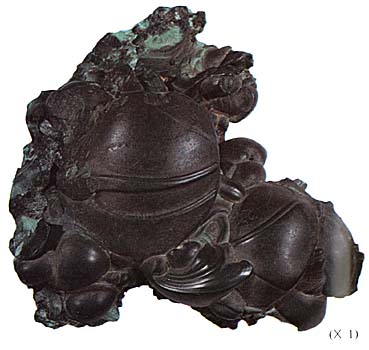
MALACHITE (No. V-252.) Ani Mine, Akita Pref.
Specimens No. V-253—No. V-270, from the Arakawa Mine, Akita Pref., occur in fractures in an oxidized chalcopyrite-pyrite-sphalerite-galena ore from an epithermal copper deposit. Malachite in deep green fibrous crystals forms botryoidal incrustations on chalcopyrite and crystalline quartz and is associated with cuprite, pyromorphite, brochantite and chrysocolla.
Cyanotrichite, Cu4Al2[(OH)12|SO4]·2H2O, very rare mineral in Japan, occurs as secondary product in the same sequence as malachite. It forms aggregates of fine acicular crystals, is pale blue in colour, and attains a few millimeters in length as in specimens Nos. V-262 & V-270.
Specimens No. V-271—No. V-273, from the Hisaichi Mine, Akita Pref., occur in a chalcopyrite-pyrite-quartz vein, and form botryoidal incrustations and radial aggregates of deep green fibrous crystals.
Specimens Nos. V-274 & V-275, from the Rendaiji Mine, Shizuoka Pref., occur in cavities in a quartz vein bearing chalcopyrite and pyrite, and form radial aggregates of fibrous crystals.
Specimen No. V-276, from the Mihara Mine, Okayama Pref., occurs in fractures in an oxidized copper ore from a contact deposit, is associated with azurite, and forms radial aggregates of hexagonal short prismatic crystals less than 1 mm in length.
Bismutite, Bi2[O2|CO3], Tetragonal, I4/mmm
< Specimen No. V-277 >
Specimen No. V-277, from the Nakanosawa Mine, Niigata Pref., is a secondary alteration product from a bismuth-bearing ore, and occurs as yellowish earthy incrustations in fractures of a quartz vein bearing native bismuth and bismuthinite.
Ludwigite, (Mg, Fe2+)2Fe3+[O2|BO3], Rhombic, Pcma
< Specimen No. V-278 >
Specimen No. V-278, from the Holgol Mine, Korea, is black acicular
crystals in radial aggregates included in dolomite marble from a contact metasomatosed
copper deposit. The crystals reach 1 cm in length (Fig. 82).
